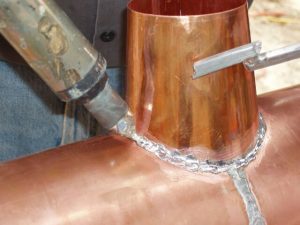MECHANICAL SOLDERING
Soldering is a method of joining similar or dissimilar metals by heating them to a suitable temperature and by means of a filler metal, called solder, having liquidus temperuatre not exceeding 450°C and below the solidus of the base material. Though soldering obtains a good joint between the two plates, the strength of the joint is limited by the strength of the filler metal used.
Solders are essentially alloys of lead and tin. To improve the mechanical properties and temperature resistance, solders are added to other alloying elements such as zinc, cadmium and silver in various proportions. Soldering is normally used for obtaining a neat leak proof joint or a low resistance electrical joint. The soldered joints are not suitable for high temperature service because of the low melting temperatures of the filler metals used. The soldering joints also need to be cleaned meticulously to provide chemically clean surfaces to obtain a proper bond. Solvent cleaning, acid pickling and even mechanical cleaning are applied before soldering.
To remove the oxides from the joint surfaces and to prevent the filler metal from oxidizing, fluxes are generally used in soldering. Rosin and rosin plus alcohol based fluxes are least active type and are generally used for electrical soldering work. Because of the content of acids, these are corrosive at soldering temperature. They can be easily cleaned after the soldering. The organic fluxes such as zinc chloride and ammonium chloride are quick acting and produce efficient joints. But because of their corrosive nature the joint should be thoroughly cleaned of the entire flux residue from the joint. These are to be used for only non-electrical soldering work. Fluxes are normally available in the form of powder, paste, liquid or in the form of core in the solder metal. It is necessary that the flux should remain in the liquid form at the soldering temperature and be reactive to be of proper use.
The most commonly used soldering methods include soldering iron (flame or electrically heated), dip soldering, and wave soldering. A soldering iron is a copper rod with a thin tip which can be used for flattening the soldering material. The soldering iron can be heated by keeping in a furnace or by means of an internal electrical resistance whose power rating may range from 15 W for the electronic applications to 200 W for sheet metal joining. This is the most convenient method of soldering but somewhat slower compared to the other methods.
In dip soldering, a large amount of solder is melted in a tank which is closed. The parts that are to be soldered are first cleaned properly and dipped in a flux bath as per the requirement. These are then dipped into the molten solder pool and lifted with the soldering complete. The wave soldering is a variant of this method wherein the part to be soldered (e.g.” an electronic printed circuit board, PCB) is not dipped into the solder tank, but a wave is generated in the tank so that the solder comes up and makes a necessary joint.
Source A Textbook of Basic Manufacturing Processes and Workshop Technology by Rajender Singh.













Post Comment
You must be logged in to post a comment.